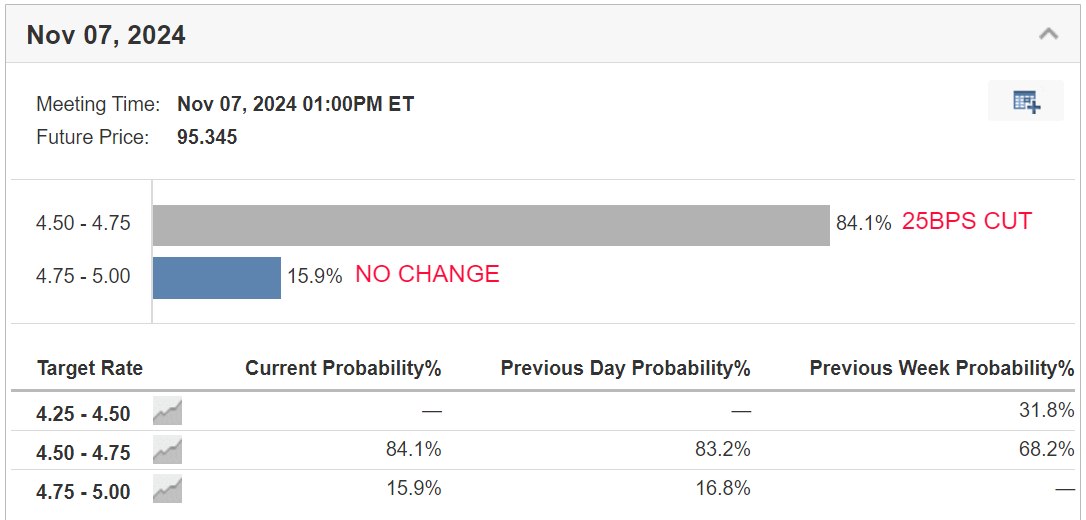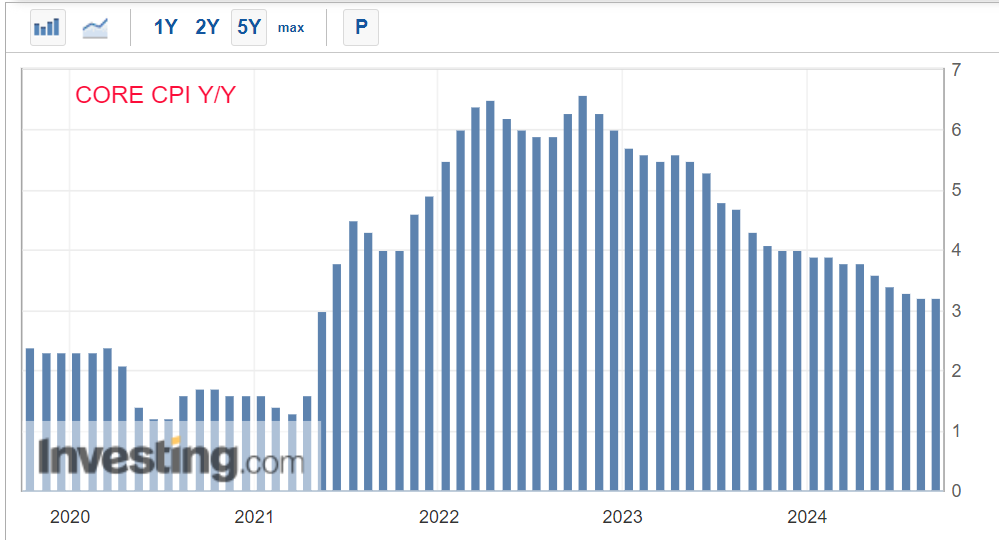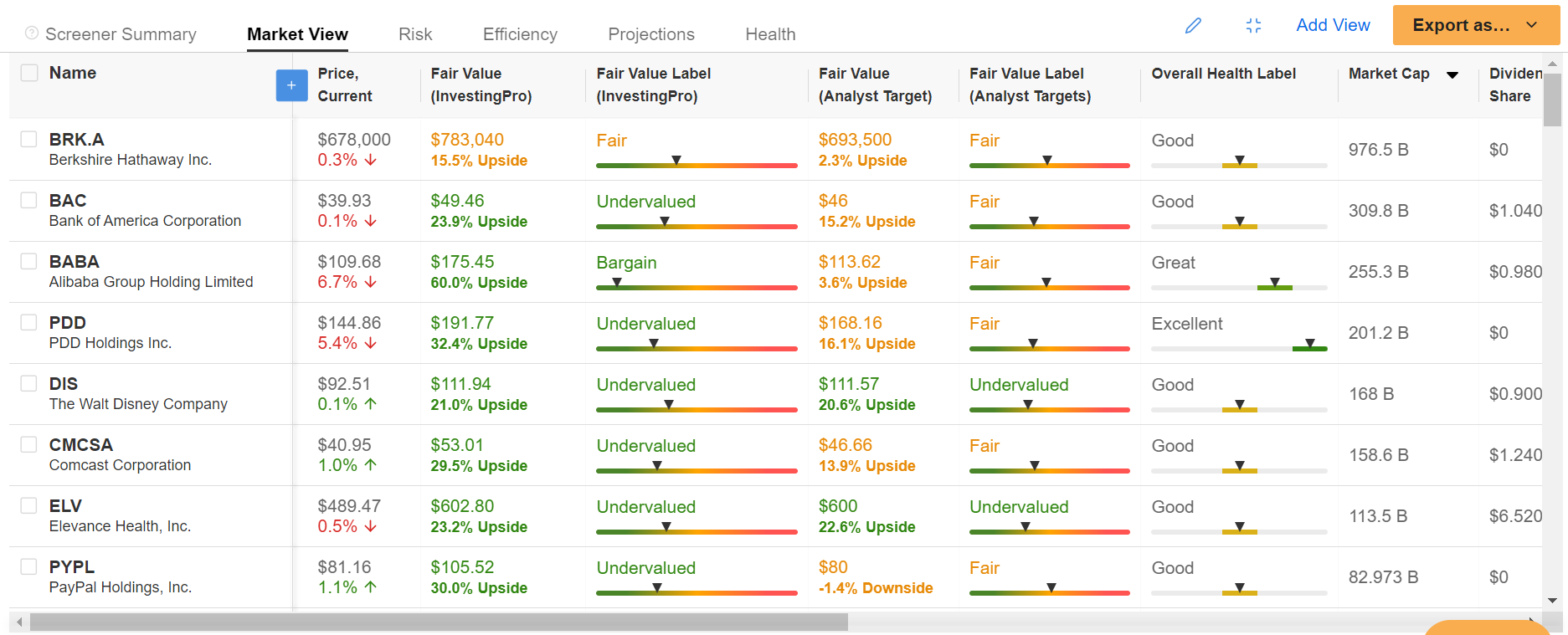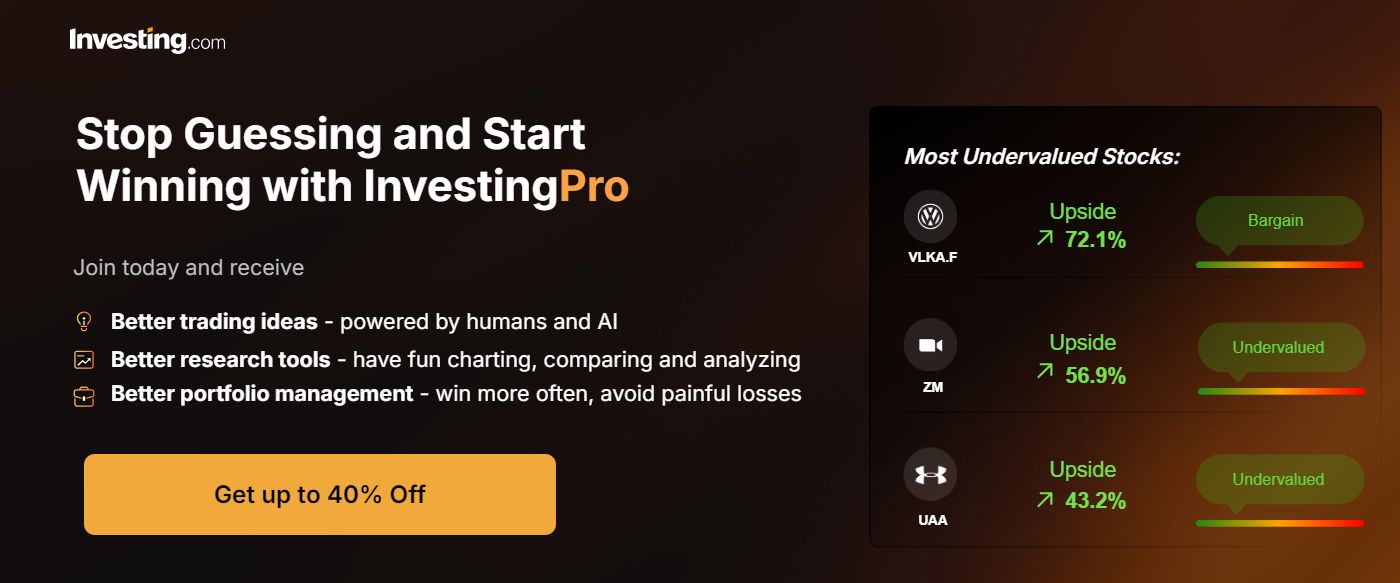- The highly anticipated U.S. September CPI report comes out tomorrow.
- Headline annual inflation is seen rising by 2.3% and core CPI is forecast to increase by 3.2%.
- Investors should brace for possible market swings after the CPI release as financial markets adjust their expectations for the Fed’s next move.
- Looking for actionable trade ideas to navigate the current market volatility? Unlock access to InvestingPro for less than $8 a month!
The U.S. Consumer Price Index () report, set for release Thursday morning, is poised to be a significant market mover, potentially shaping the Federal Reserve’s next steps on interest rates.
The data will follow last week’s strong , which already reduced the of aggressive near-term rate cuts.
Currently, the market is pricing in an 84% probability of a 25-basis point rate cut on November 7, according to Investing.com’s Fed Monitor Tool, and a 16% chance of no cut at all.
Just a few weeks ago, the odds for a jumbo-sized 50bps cut stood at around 50%.

Source: Investing.com
With market expectations on edge, the upcoming CPI report could solidify or upend current forecasts for the pace of monetary easing.
A stronger-than-expected print could further limit the Fed’s flexibility, casting doubt on the prospects for rapid monetary easing.
As such, this Thursday’s CPI report will be a crucial test for both the economy and financial markets.
Key Expectations and Implications for September CPI
Economists predict a modest 0.1% rise in headline inflation for September, marking the smallest increase in three months.
Year-over-year, headline CPI is expected to cool to 2.3%, down from 2.5% in August, extending a six-month streak of decelerating price pressures. If that is confirmed, it would mark the lowest annual reading since February 2021.
Source: Investing.com
However, the more closely watched , which excludes food and energy prices, is forecast to rise by 0.2% , maintaining a steady 3.2% annual increase.
Source: Investing.com
If inflation falls more than expected, it could strengthen the arguments of Fed doves advocating for a more aggressive rate-cutting cycle and could potentially put another 50bps rate cut on the table for November.
Conversely, a hotter-than-expected core CPI reading could lead some of the more hawkish members of the Federal Open Market Committee (FOMC) to hesitate about cutting rates at all next month.
An inflation surprise to the upside could force investors to further dial back their expectations for the extent of easing this year, making it less likely that the Fed will move quickly to lower rates.
What to Do Now
Given the current macroeconomic environment, with inflation in focus and uncertainty around the Fed’s next moves, investors need to adopt a cautious yet strategic approach to their portfolios.
Volatility may spike depending on the CPI report’s outcome. If inflation comes in above estimates, the chances of a more hawkish Fed could lead to market turbulence, especially for growth stocks sensitive to rising interest rates.
Defensive sectors like utilities (NYSE:), healthcare (NYSE:), and consumer staples (NYSE:) may offer a safer refuge in this scenario.
However, if the CPI data points to cooling inflation, tech stocks—especially those involved in AI and semiconductors—could see continued investor enthusiasm.
Using tools like the InvestingPro Advanced Stock Screener can help identify high-quality companies that are substantially undervalued and have healthy growth prospects.
Some notable names include Warren Buffett’s Berkshire Hathaway (NYSE:), Bank of America, Alibaba (NYSE:), Temu owner PDD Holdings (NASDAQ:), Walt Disney (NYSE:), Comcast (NASDAQ:), Elevance Health (NYSE:), PayPal (NASDAQ:), Lennar (NYSE:), Square parent Block (NYSE:), Humana (NYSE:), and Marathon Petroleum (NYSE:).

Source: InvestingPro
Conclusion
In summary, Thursday’s inflation report is a pivotal event that could either pave the way for further Fed easing or throw a wrench into the current market narrative.
A lower-than-expected inflation print could support the case for more aggressive rate cuts, while a hotter number would likely temper expectations, putting markets on alert for a more cautious monetary policy approach from the Fed.
Markets are likely to remain sensitive to economic data, so keeping a close eye on the evolving inflation landscape is crucial for positioning portfolios for success.
Be sure to check out InvestingPro to stay in sync with the market trend and what it means for your trading.
Subscribe now to get an additional 10% off the final price and instantly unlock access to several market-beating features, including:
- InvestingPro Fair Value: Instantly find out if a stock is underpriced or overvalued.
- AI ProPicks: AI-selected stock winners with proven track record.
- Stock Screener: Search for the best stocks based on hundreds of selected filters, and criteria.
- Top Ideas: See what stocks billionaire investors such as Warren Buffett, Michael Burry, and George Soros are buying.
Disclosure: At the time of writing, I am long on the S&P 500, and the via the SPDR® S&P 500 ETF, and the Invesco QQQ Trust ETF. I am also long on the Technology Select Sector SPDR ETF (NYSE:).
I regularly rebalance my portfolio of individual stocks and ETFs based on ongoing risk assessment of both the macroeconomic environment and companies’ financials.
The views discussed in this article are solely the opinion of the author and should not be taken as investment advice.
Follow Jesse Cohen on X/Twitter @JesseCohenInv for more stock market analysis and insight.


